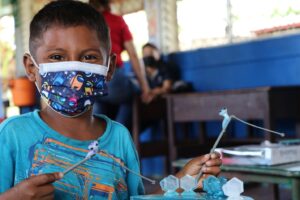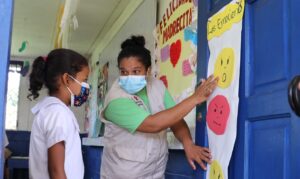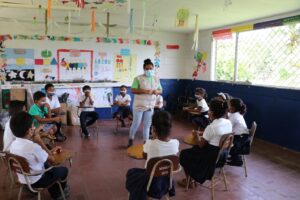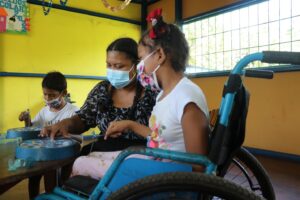How play is helping children in Nicaragua recover from the aftereffects of Hurricanes Eta and Iota

“When I play I feel happy,” says Angeline. She’s a student at a local elementary school in Waslala, Nicaragua.
Angeline is one of nearly 16,000 children to receive a toy as part of Save the Children’s ongoing collaboration with Spin Master’s Toy Movement initiative.
“With the Magic Screen (Etch-a-sketch) I feel like I’m making a work of art,” she says. “I’m learning the vowels, how to draw eggs, chicken, cakes, and fish. With this gift, I feel happy.”
Watch this video now:
Angeline’s home in Waslala is in a remote region in central Nicaragua, accessed by steep mountainside roads. Repeated exposure to natural hazards like hurricanes and floods have limited access to education, economic opportunities and electricity, among other things.
Hurricanes Eta and Iota
In November 2020, Nicaragua was hit by Hurricane Eta, a category four storm, and Hurricane Iota, a category five storm, just 15 days apart. Forty-four per cent of the inhabitants of the North Caribbean region—of which Waslala is part—were displaced from their homes.
Waslala and its neighbouring regions experienced severe flooding and landslides, interrupting critical communication infrastructure and making the already remote part of the country more difficult to reach.
For children like Angeline, it was the first time they had experienced a hurricane in their lives.
 STC Nicaragua staff member, Jennifer, leads a Play On! activity with children in Nicaragua.
STC Nicaragua staff member, Jennifer, leads a Play On! activity with children in Nicaragua.
Photo: Save the Children
“In this area, hurricane Eta and Iota have directly affected the families,” says Jennifer, a staff member at Save the Children.
Seventy per cent of children affected by the hurricanes reported high levels of stress and prolonged grief in the aftermath.
Play On! In Nicaragua
As part of the recovery phase of the humanitarian response to the devastation of hurricanes Eta and Iota in Nicaragua, Save the Children staff implemented the Play On! Curriculum, in coordination with regional and municipal governments, the Ministry of Education, the Ministry of the Family, the Ministry of Youth and Women.
Funded by Spin Master, a Canadian-based leading children’s entertainment company, the curriculum is a targeted mental health and psychosocial support (MHPSS) program for children designed to help children play, learn, and recover from traumatic experiences in a safe environment using toy-based play. The curriculum includes toy-based activities; guidance for teachers and facilitators; and dozens of breathing and stretching movements that target MHPSS.
Currently a very small percentage of overall humanitarian funding is used for child protection, mental health and psychosocial services, and education in emergencies.

Through the Play On! Curriculum, children in Nicaragua have the opportunity to play, learn, and recover from the psychosocial effects of the hurricanes in a safe environment.
Photo: Save the Children
The Play On! Curriculum has the potential to help fill this gap. It has been translated into multiple languages including Spanish and Miskito, and adapted for use in refugee camps, like those in Dadaab, Kenya, increasing awareness of the need for funding for mental health and psychosocial support for children in emergencies.
Save the Children has been partnering with Spin Master for the past six years. Known for much-loved toy brands like PAW Patrol, Bakugan and Kinetic Sand among others, Spin Master creates memorable play experiences for children through innovative toys, engaging entertainment and creative digital games.
The Toy Movement is a philanthropic initiative from Spin Master that provides toys to children who are disadvantaged and displaced around the world with the hope of bringing inspiration, imagination, and joy through play. Spin Master’s mission with the Toy Movement is to share the message that children are not alone, that they are not forgotten, and that they deserve to grow, learn and explore through play—as all children should.
Play-based learning for children with disabilities
Three hundred kilometres away in Bilwi, a coastal community in the North Caribbean region, Johaira works as the director of a school for children with disabilities. She says her students—many of whom come from families with limited resources—were severely affected by the two hurricanes.

The Play On! Curriculum and toys from Spin Master have helped facilitate learning for children with disabilities in Nicaragua.
Photo: Save the Children
The Play On! Curriculum and the toys have made a significant difference for them, too.
“It brings them joy; it brings them safety here at the school. They get so excited that they come to class every day and they bring their toys,” she says. “The Toy Movement has extraordinarily benefited the school and students with special needs, because it has allowed them, through the toys, to develop skills that facilitate learning.”
Learn how you can help reach the most vulnerable children with the message that they are not alone, that they are not forgotten, and that they deserve to play, learn, and grow—as all children should.
by Alison Ralph


